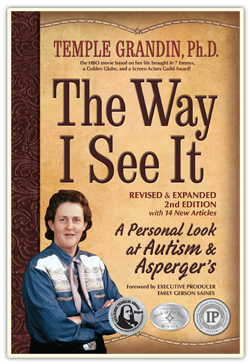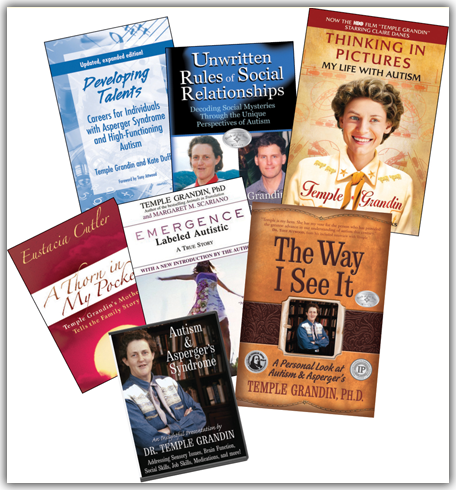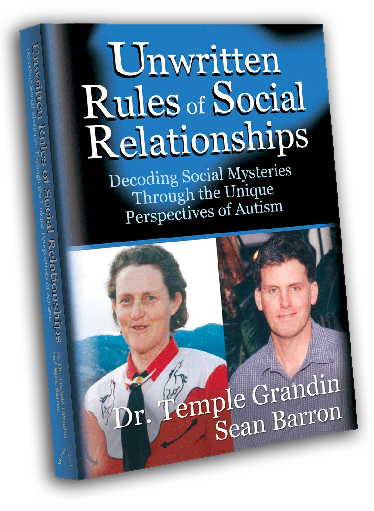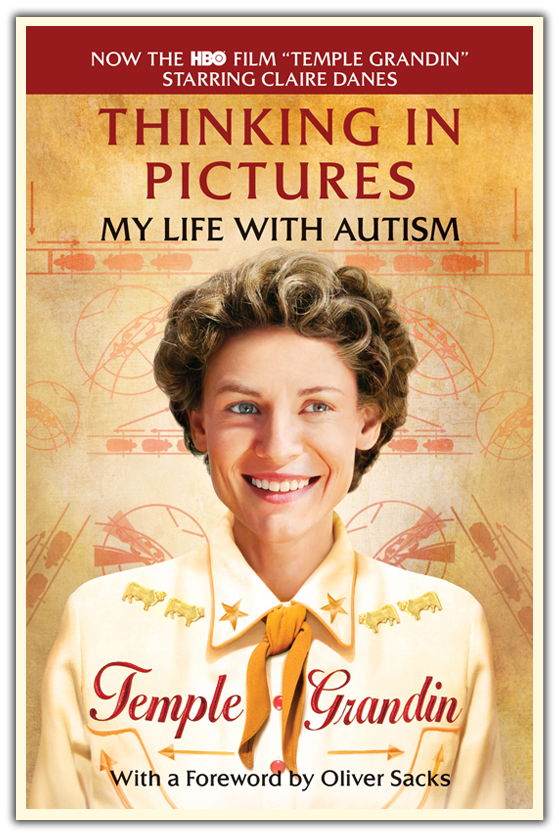
ASK TEMPLE!
Go here and your question will be sent to Temple! She will answer as many as she can. Periodically, new questions will be posted on this page, so stay tuned.
Temple Grandin Conferences
August 10 - Tulsa, Oklahoma
August 17 - Omaha, Nebraska
September 7 - Pittsburgh, Pennsylvania
September 14 - Raleigh, North Carolina
October 12 - San Francisco, California
October 19 - Kansas City, Missouri
November 2 - Austin, Texas
November 3- - Salt Lake City, Utah
NEW Book by Temple
JUST RELEASED!
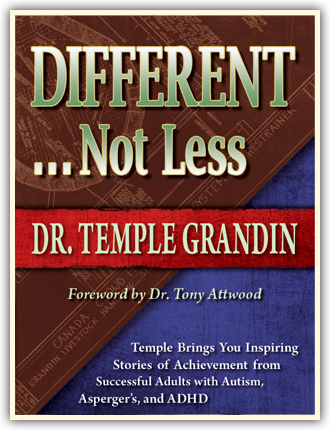
Read the fantastic review by an Occupational Therapist!
Click here to view this catalog as a PDF!
Brand new revised version of
Temple Grandin's "The Way I See It"!
Temple Grandin Library.
Six books and her ninety minute presentation on Autism. Savings of over $60.00 plus FREE shipping!
Frequently Asked Questions
DELAYED SPEECH
You need to start working with your child now. Many scientific studies show that early educational intervention improves a child’s prognosis. The earlier the teaching starts, the better. The worst thing you can do with a young autistic child is nothing. Letting your child watch TV all day is really bad. If no services are available, you need to get volunteers to work with your child. Grandmothers and college students majoring in education are good sources of volunteers. Use the social networks you have in your church, synagogue, mosque, or community group to locate people. Some people have the ability to work with children with autism and others do not. A young child with autism should have a minimum of 20 hours per week engaged in one to one teaching. An effective teacher will be able to achieve more language, better turn taking skills, and better social interaction. The child’s brain needs to be kept engaged with the world.
Suggestions for Teaching
-
Teach your child words. When you give him/her a snack, name the food when you give it to him/her. For example, say “apple” when you give your child an apple.
-
Play lots of games that involve turn taking. If the child is spinning a penny, turn it into a game of taking turns. Children’s board games, such as Candyland, are good for teaching turn taking. When a child gets older, use board games that are suitable for an older child.
-
Limit TV and video game playing to one hour per day.
-
Sing nursery rhymes and play other interactive children’s games. Always try to encourage social interaction and eye contact.
-
Use lots of positive reinforcement, smiling and praise. Encourage the child to give you a smile.
-
Use each mealtime to teach social interaction and manners. Structured meals where a child learns social skills are part of a 20-hour week program.
-
Make sure your child gets plenty of exercise. Exercise has a calming effect. Cut excess sugar out of their diet. Make sure he/she has a good breakfast that contains lots of protein such as meat, eggs, dairy or peanut butter. Sugar loaded foods such as Pop tarts or powered sugar donuts are bad. Eating protein, especially at breakfast, really helps one to be calmer, focused, and less likely to get headaches.
WEEKLY THERAPIES
No. Research shows that a minimum of 20 hours a week of one to one teaching is most effective. However, one hour a week is enough time for the professionals at the school to be mentors and trainers of parents and volunteers. You need to observe the sessions with the professionals at the school so they can work with your child more effectively. Further information is in the answer to Question 1.
PICKY EATERS
I am very concerned that some children with very limited diets may have vitamin deficiencies. The first step is to give him/her a multiple vitamin. Parents should work closely with their pediatrician or other health professional. To encourage eating more variety, try putting a small amount of a new food next to the child’s favorite food. Tell him/her they have to try the new food first. Some children do not want to try new things because it is new. You can let your child touch, explore, and play with the new food in the kitchen. Never allow food playing the dining room because it is bad manners. Do it in the kitchen. Other tips for the child that will only eat certain take out, fast food, or snack food is to try putting a similar homemade food in the same package.
BIOMEDICAL TREATMENTS
The most important biomedical treatments to try are the special diets. They are most likely to help children who have gastrointestinal problems. They do not work for everybody. A special diet does not cure autism, but in some children, there may be definite improvements. Parents have reported improvements such as more language, less hyperactivity, and fewer tantrums. I am going to provide a basic overview of diets that can be easily implemented by buying regular food. It does not have to be organic. All fresh fruits and vegetables should be washed before eating. For families on a budget, it is possible to do special diets with economical foods. I have found that greatly reducing the amount of wheat in my diet has helped reduce skin rashes and eczema. There are three basic types of special diets. A child should always take a good multivitamin.
-
Gluten-free – Wheat is the most important item to remove. Most breads, cakes, and cookies contain wheat. Labels on processed food need to be read carefully to make sure all the gluten is removed. If the diet is going to work, results should become obvious in three months. Sometimes when a child first goes gluten-free, there will be a period where her/his behavior will get worse before it gets better. For example, a gluten-free diet can be done easily with economical foods such as rice, hamburger, fresh fruits, nuts, vegetables, beans, potatoes, and dairy products. Rice cakes, rice noodles, cornbread, corn chips, and corn tortillas can be used as economical bread substitutes.
-
Dairy/casein-free – In this diet, all dairy products and foods containing derivatives of dairy such as casein, are removed. Foods in the dairy class include cheese, milk, yogurt, ice cream, and cottage cheese. If a dairy-free diet is doing to be beneficial, you should see results in one month. Some children who do not tolerate milk can eat plain yogurt that contains active yogurt cultures. I eat lots of Dannon plain yogurt. Some kids need to be off both gluten and dairy. For some children, soy milk is not recommended as a dairy substitute. Soy products may cause problems in some children.
-
Carbohydrates – All children will benefit if the amount of sugar they eat is limited. If I eat a high carbohydrate breakfast of a sugared cereal, I am dizzy and light headed by 10 AM. A good breakfast containing lots of protein prevents this. Eggs, sausage, and a piece of fresh fruit is what I eat for breakfast. It is better to eat whole fresh fruit instead of juice. This lowers the glycemic index. The specific carbohydrate diet is similar to an Atkins diet. Complex, starchy carbohydrates, such as potatoes, rice, and bread are removed. I have found that greatly reducing high glycemic carbs has helped me control yeast infections. Yeast infections often get worse if lots of sugar is consumed.
-
Other Biomedical Treatments – Some of the other biomedical treatments that have scientific backing are fish oil Omega 3 supplements, and B6 and magnesium. The American diet is deficient in Omega 3. Salmon is a good source of Omega 3 and I eat some every week. Some of the other supplements, such as amino acids, may be helpful. Try one thing at a time. Tyrosine has been shown to have a calming effect in ADHD. Be careful not to take too much. Too high a dose may have a bad effect. SHTP, the precursor of tryptophan may also be helpful. Tryptophan has been shown to have a calming effect on animals. Be very careful in individuals taking antidepressants or St. John’s Wort. Antidepressants, St. John’s Wort and SHTP all raise serotonin levels. If the serotonin levels get too high, the result is agitation and insomnia. If a child becomes agitated on these supplements, the dose is too high. The supplement should be stopped immediately. I have found that probiotics have helped me to control urinary tract and yeast infections. Plain Dannon yogurt has been helpful. There are many probiotic products on the market. The products that have worked best for me have high levels of lactobacillus acidophilus, and bifidobacterium lactis. Melatonin is often helpful as a sleep aid. One of my favorite books on biomedical treatments is Healing the New Childhood Epidemics by Kenneth Bock, M.D. (2007), Ballentine Books.
CONCLUSIONS– Parents should work closely with their doctor or other health provider to monitor their child’s progress. Many supplements and conventional pharmaceuticals interact with each other. This is why it is so important to carefully try one thing at a time.
NOISE SENSITIVITES
The child can wear headphones or earplugs when he/she goes in a noisy place. However, it is important to never wear the headphones or earplugs all day. This will make your child more sensitive to sound. The earphones or earplugs must be off for at least half the day.
Children with autism, sensory processing disorders, ADHD and many other disorders, will tolerate loud sounds more easily if they initiate or have control of exposure to the sound. If a child cannot tolerate being in a noisy supermarket, let him/her control the amount of time spent in the supermarket. If he/she fears the smoke alarm, take an old smoke alarm and wrap it up in a towel and let the child turn it on. Gradually he/she may be able to tolerate it with less and less towels wrapped around it. Another approach is to put the dreaded sounds on a recording device. In some cases, this may not work because some electronic audio formats are compressed and do not provide a high fidelity recording. A very high fidelity recording is needed. If a high quality recording is available, the child can turn it on all by him/herself at gradually increasing volume. It is essential that the child has control.
FLORESCENT LIGHTING
-
Move the child’s desk over by the window.
-
Provide the child with an old fashioned incandescent lamp.
-
Try colored overlays or printing homework and reading materials on pastel paper. Try grey, tan, light green, light blue, light pink, light yellow, and other pale colors.
-
Irlen colored lenses help many children and adults. The child or adult tries on many different pale colored lenses until the best color is found. Each person has to find the right color that works for them. For families on a budget, try different pale colored sunglasses at a local store. Often the color that often works best is pale lavender, pale tan, pale pink, and other pale colors. Experiment with different colors. The tints must be pale because reading with lenses that are too dark would cause eyestrain. If your school has a theater department, you could experiment with the gel papers that are put on colored theater lights. To find the right tint, try reading a book under florescent lights when you try on different colors. Small pieces of theater gel paper can be taped to old glasses frames. When the right color is found, a local optician could tint the lenses. Sometimes the color that works on the lens is different than the color that works on the child's paper. If you are not on a budget, I would recommend going to an Irlen provider who is skilled at helping people find the right color.
BUILDING WITH LEGOS, ETC.
Yes. Parents and teachers should strive to encourage a child’s creativity. When I was in elementary school, my mother always encouraged my ability In art. It is important to broaden out the talent. If I had been left alone, the only thing I would have drawn would have been horse heads. To expand your child’s ability, encourage making drawings of things that are related to a child’s fixation. I was encouraged to draw other things. Some examples would be the horse’s stable or a place you might ride a horse. He/she needs to learn how to do drawings that other people will want and appreciate.
FIXATIONS
Use the motivation of a fixation to motivate other activities. If trains are a child’s favorite thing, read a book about trains, do math with trains, and teach science with trains. Read about a place a train travels to, or calculate how long it takes a train to travel between two cities.
CHORES
Yes. Doing chores teaches elementary school children important skills on doing work for others. When I was 13, I had my first job two afternoons a week. Below are all the work experiences that I had before I graduated from college. Learning work skills is extremely important and work experiences should start in middle school. Today good work experiences for teenagers could be: walking dogs, fixing computers, mowing lawns, making PowerPoint presentations, making greeting cards and selling them, or writing for a church or community newsletter. They need to do tasks that other people will value. Volunteer work counts as work.
My Teenage Work Experience
-
13 years of age – Hand-sewed hems and took apart garments two afternoons a week for a freelance seamstress.
-
15-years of age - Took care of nine horses. I cleaned their stalls and fed them.
-
16 years of age – Worked on my aunt’s ranch building a gate that could be opened from a car and other projects.
-
In college, I interned one summer in a research laboratory.
MEDICATIONS
There are way too many powerful medications with severe side effects casually given out to young children. I am very concerned about possible long-term damage to the child’s developing nervous system. This is especially a concern when powerful antipsychotic drugs are given. They may cause tardive dykinesia,which may cause permanent Parkinson-like shaking. For more complete information on medications you will need to read the medication chapters in the 2006 edition of Thinking in Pictures and the 2010 2nd Edition of The Way I See it. In young children, it is usually recommended to try interventions, such as special diets first, for treating behavior problems that are related to autism.
There are some older children and adults who will need conventional medication to control behavior. My anxiety and panic attacks were 90% eliminated with a low dose of antidepressants. Often a very low dose of a drug such as Prozac (fluoxetine) works for anxiety. If the dose is too high, it may cause agitation and insomnia. If agitation occurs, the dose must be immediately lowered. The correct dose of an antidepressant may be only ¼ to ½ the normal starter dose. Other medications that are useful for calming are blood pressure medications such as clonidine, beta blockers, such as propranolol and Minipres (prazosin). Antidepressants, blood pressure medications and the stimulants have less severe side effects compared to antipsychotics. However, there are some cases of severe aggressions where a low dose of antipsychotic such as risperdal (risperidone), Ambilify (aripiprazole) or Screquel (quetiapine) may be required in older children and adults.
**Of course, prescription drugs should be scripted by a physician that has examined the child and knows their medical history.
SLEEP HABITS
Try simple things first such as making sure your child gets lots of exercise and reducing sugar in the diet. Some children sleep better under a heavy weighted blanket. Another tip is to have quiet, calming activities that become a routine before bedtime. Some examples would be reading a story or singing calming songs. Powerful anti-psychotic drugs such as risperdal (risperidone), Seroquel (quetiapine) or Ambilify (aripiprazole) should not be used as sleep aids because they have too many severe side effects. Safer alternatives, such as Melatonin, Benadryl, or clonidine are sometimes helpful.
SCHOOLS AND DOCTORS
Unfortunately there is no way for me to make specific recommendations for schools or doctors. Only people in your local community are qualified to give specific recommendations. For parents with a newly diagnosed child, I recommend joining a local autism support group. Google and other search engines are very useful for finding schools and other resources. To find a school, type in the keywords: autism, school, and your city or state. I strongly recommend that you visit a school before you enroll your child. The best results are not always on the first page of hits. Keep looking at more pages until the search gets off the subject and then try different keywords. Some examples are “classes, programs, resources.”
VISION IN HORSES
Horses have wide-angle vision and most of their visual field is monocular with no depth perception. Some people have stated that a horse has to be taught everything twice due to its monocular vision. The reason why it has to be trained in many different locations is due to its specificity of thinking. Horses and other animals are sensory-based thinkers. An object, such as a car, may be perceived as two totally different things when viewed from the front or side. The front view looks different than the side view. This is why it is so important to carefully and quietly expose horses to many new things.
ANIMAL SHELTERS
The single most important thing that dogs need EVERYDAY when they are in an animal shelter is one hour of quality time being walked and played with by a volunteer. In a new shelter, dog kennels should not face each other because it encourages barking. Sound absorbent materials hung from the ceiling can help absorb noise.
ANXIETY
During my 20’s, I had increasingly severe anxiety and panic attacks. Hard exercise and physical work helped. For me, the only thing that really stopped the panic attacks was a low dose of antidepressants. Low doses are essential to prevent side effects such as insomnia and agitation. Many people have found Prozac to be effective. I recommend reading the medical sections in Thinking in Pictures and The Way I See It, 2nd Edition.
DISCIPLINE
I cannot emphasize the importance of consistency. When I was in elementary school, the penalty for having a tantrum was to have no TV for one night. That was the rule and it was always enforced. It is essential for the rules to be consistent at BOTH home and school. Parents and teachers must work together otherwise the child may manipulate the parent against the teacher and vice versa. Kids need to learn that “No” means No and be rewarded when they do things right. You also need to determine if a behavior problem is caused by pain or sensory over sensitivity. Hidden painful medical problems must be ruled out. Some common ones are – acid reflex (heartburn), constipation, yeast infections, toothaches, and earaches. A child may fear going into a room where a smoke alarm had previously gone off, because it hurt his/hear ears. After these biological causes of behavior problems are ruled out, then the behavioral motivation can be figured out.
The three main behavioral causes of tantrums and other problems behaviors are:
-
Get attention
-
Frustration because communication is difficult
-
Escape from a task
Each one of these motivators needs to be handled in a different way. Often the best way to handle behaviors motivated for attention getting is to ignore it. If a non-verbal child is frustrated because he/she cannot communicate, he/she should be given a means to communicate, such as a picture board or picture exchange. There are many new apps available for I Pads and other tablets for communication. If the child is trying to escape from a task, you need to make sure the task is not stupid. An example of a stupid task would be making a brilliant 8-year-old do baby math drills. He/she should be given the more advanced math book.
All children in the autism spectrum should be expected to do daily living tasks that they are capable of doing. Some examples are making their bed, being on time for the school bus or helping with household chores. When I was a child, I was expected to have good table manners and to say “please” and “thank you.” When I made a mistake with table manners, mother did not say No. She told me the correct behavior. For example if I ate mashed potatoes with my fingers, she said, “No, use your fork.” She gave me the instruction, instead of just saying NO.
POLICE AND AUTISM
Many meltdowns and outbursts in public are caused by sensory overload. First of all, the police and other emergency workers need to be trained so they understand how sensory over sensitivity can cause meltdowns. Training of the police would help prevent these unfortunate incidents from being repeated. Meltdowns are different than ordinary anger because the entire nervous system has gone into overload.
Some good resources are:
-
Deborah Lipsky – Managing Meltdowns using the S.C.A.R.E.D. Calming Technique with Children and Adults with Autism, Jessica Kingsley Publishers.
-
Temple Grandin, The Way I See it, 2nd Edition, Chapter entitled - Innovative Methods for Handling, Hitting, Biting, and Kicking.
-
Readers submit suggestions for other police training resources.
EXCELLING IN ACADEMICS
Children on the Spectrum often have uneven skills. I have talked to parents of many children who are brilliant in Math and poor in Reading. If a third grader is capable of doing high school Math, he should be provided with the advanced books. If he is forced to do baby Math, he will become a behavior problem.
Since kids on the spectrum often have uneven skills he may need special education in Reading.
Children who had advanced skills should be doing advanced work so they can develop their ability. It is also important to teach the importance of helping others. A child with advanced skills will help teach and tutor other children. Never hold a smart child back!
JOB INTERVIEWS
I never found work by filling out a job application and doing a normal interview. I found work by always having my portfolio with me and showing it off when the opportunity arose.
When I was in Graduate School I painted signs for local businesses and the carnival at the Arizona State Fair. When I went to the Fair I met a sign painter and showed him my portfolio. The next day I was painting signs on carnival attractions. I carried my portfolio of completed sign projects in a black notebook. Today, a person can carry it on their Smart Phone.
My next step was writing for a farm magazine. I had the guts to go up to people and show my work. Kids need to build confidence to do this. This is why Middle and High School are important. When I was a child I sold candy door to door for charity. This activity built confidence. My sign painting job led to selling cattle design projects; one small project at a time.
I sold my skills by showing a portfolio of photos, drawings and articles. I learned very early that the door to opportunity was showing my portfolio to the right person. The right person could be anywhere, such as a supermarket or a family party. Today with social networking, it may be even easier to get samples of your work out where people can see it.
TEACHERS AND AUTISM STUDENTS
Answer: Many children with autism and other developmental disorders will have problems with sensory over sensitivity. They may have difficulty when the classroom becomes noisy and confusing. Some children cannot tolerate florescent lights because they can see flickers like a flashing strobe light. I recommend reading the sensory section in my book The Way I See It. When a child with autism becomes over stimulated, he/she may need to take a break away from the noise in a quiet location.
Children with autism do not pick up social cues from other people. They need to be instructed on how to behave. The best way to do this is to take advantage of natural “teachable moments.” For example, if a child with autism fails to wait for his/her turn during an activity, do not yell “No.” Instead, calmly give the instruction on what the child should do. Tell him/her, “Wait until Jim has taken his turn.”
Some children with autism get too close and crowd another child’s space. If this occurs, give the instruction. Tell him/her “Jimmy does not like it when you get so close and you keep touching him.” It may be a good idea to teach the child with autism how to do the High five hand clap with another child. You will need to demonstrate how to do high fives, and then he/she can greet other children in a socially appropriate way. He/She will also need to be taught how often it is appropriate to do high fives. Doing it ten times is not appropriate.
Every social interaction has to be taught. If the autistic child is bothering the other children by telling them some story about dinosaurs 20 times, you should tell him/her that he/she should tell that story no more than twice. When I was little and I forgot to say “please” mother would stop me and say, “you forgot to say please.” I would usually say it before she got to the word “please.”
The Social Stories books by Carol Gray may be helpful. This is a system where the child is given written scripts on how to behave in different situations.
Children on the autism spectrum often have problems with remembering long strings of verbal instruction. If the child has good reading skills, give him/her written instructions. Vague instructions do not work with children with autism. For example, give the child an exact date that the homework is due. Be patient if the child asks lots of questions because he/she dot not understand exactly what the assignment is. Children on the autism spectrum need specific detailed instructions so that they understand the assignment.
TURNING POINT
There is no single turning point in life. There were a series of important events that helped me to develop. First of all, I got excellent early educational intervention and mother was always pushing me to do new things. The second step was having a series of mentors, such as my aunt on the ranch, my high school science teacher, and good people in the livestock industry.
The third essential step for me was antidepressant medication that stopped my constant anxiety and panic attacks. I started taking them in my early 30’s. Many stress related health problems went away when I took low doses of antidepressants. Many people do not need medication, but for me it was essential.
My first book was titled, “Emergence” and that title really explains my life. I gradually developed and emerged. If you have an older child or adult who is not progressing, it is never too late to start. I met a 20-year-old who had not learned to drive and he had been too sheltered by his family. When he got a job away from the family, a friend taught him to drive and he got his license. People on the spectrum have to be “stretched” to keep learning new skills.
Adults Ask: Am I on the autism spectrum?
By Temple Grandin
I have adults contact me all the time and ask, “Is it possible that I am on the autism spectrum or have Asperger’s?” This usually occurs when either their child or their grandchild is diagnosed. It is very likely that they are on the autism spectrum. I had a retired NASA space scientist walk up to me at an autism talk and he told me his grandson had just been diagnosed. He said half the engineers at NASA were probably on the spectrum.
The autism spectrum is a broad spectrum that ranges from very severe to mild. There is NO black and white dividing line between the autism spectrum and being so-called normal. In my new book, “Different Not Less”; people on the spectrum who were diagnosed later in life tell their own stories. They got a formal diagnosis because their marriages and relationships had many problems. This provided great insight.
Older people who suspect that they are on the spectrum ask me all the time if they should get a formal diagnosis. If their job and life is stable, I recommend keeping it off the electronic medical records. They can obtain understanding by reading books on autism and attending meetings. The only reason to get a formal diagnosis is to obtain services.
Autism diagnosis is not precise like a diagnosis for tuberculosis. It is a behavioral profile. When the DSM-5 comes out, the Asperger diagnosis will be dropped and merged into autism spectrum disorder or ASD. They will also add a new diagnosis of social communication disorder, which is simply autism without the repetitive behavior or fixated interests. Do not get hung up on labels. Over the years, the doctors keep revising and changing the labels and their meaning. Nobody is doing this with a diagnosis of malaria or strep infection. You either have these diseases or you do not. Autism spectrum is a broad spectrum that ranges from very severe to merging into being a personality variant at the far end of normal.
Learning the Meaning of Prepositions and words such as "up", "down", "over" and "under".
Basic sight words have to be learned by memorization, but ALL words have to be learned by specific examples. For example, to teach the word "down" you need lots of different examples. For the word "down" you could use the following:
The airplane goes "down" and lands.
I sat "down" in the chair.
I laid "down" in the bed.
I walked "down" the stairs.
Use a similar approach for words such as "in", "on", "over", "under" or "beneath". An example you could use would be "beneath" the table, "beneath the tree", etc. For words such as "it" and "the", you need to teach them with pure memorization with many specific examples of sentences with "it" and "the".

